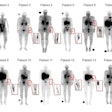Lead study author Dr. Christian Buchbender, from the department of diagnostic and interventional radiology, and colleagues evaluated DWI-MRI, FDG-PET, and PET/MRI for staging head and neck cancer patients.
Preoperative 3-tesla MRI, including DWI and gadolinium-enhanced sequences, and FDG-PET/CT were performed in 14 consecutive head and neck cancer patients with a mean age of 67 years. Using image fusion software, PET and DWI images were combined with corresponding T1-weighted, gadolinium-enhanced MRI studies.
PET/MRI detected 26 of 28 (93%) positive lymph node metastases, compared with 20 of 28 (71%) metastases for DWI-MRI, according to the researchers. In addition, the sensitivity, specificity, positive predictive value, negative predictive value, and accuracy of PET/MRI were greater in all five categories compared with DWI-MRI.
"Our approach was to find out if the number of initially false-negative neck scans can be reduced by the use of molecular MRI information in simultaneous FDG-PET/MRI," Buchbender said. "However, according to our first results, the use of 'PET-like' DWI did not increase the sensitivity of lymph node metastases detection compared to FDG-PET/CT. We plan to evaluate whether the combination of FDG-PET/MRI plus DWI does perform better in this task."
Now that simultaneous PET/MRI is available, Buchbender and colleagues have started to combine several MRI parameters with FDG-PET to find out if such a combination achieves a higher detection rate for lymph node metastases and, if so, which combination is the most beneficial.




















